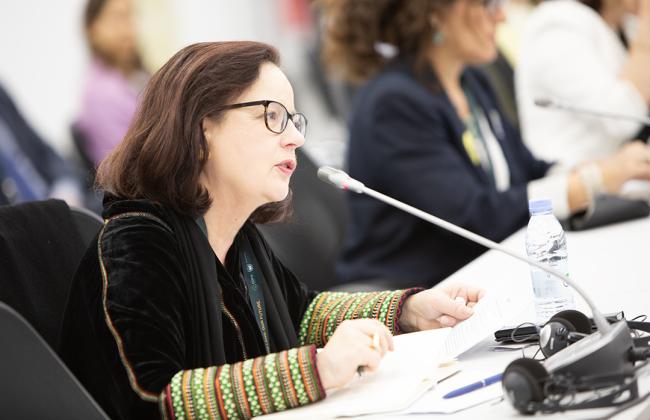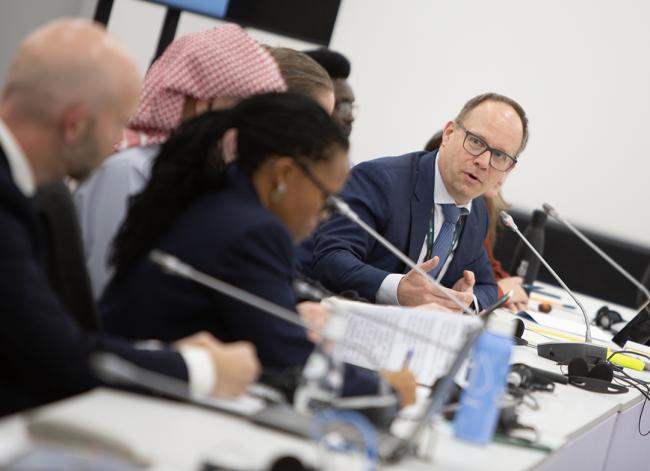About
A Just Land Transition would enable restoration of drylands while ensuring jobs, agricultural productivity, and social safety nets. Realizing this vision, speakers suggested, will require not only funding but also empowering community-based and women-led organizations.
What is a Just Land Transition and why do we need one? This event delved into what governments, businesses and people must do to achieve inclusive land restoration that leaves no one behind. Sustainable land management, land restoration in drylands, and women-led community action are all part of the mix.
Cornelia Meyer, Chairman and CEO, Meyer Resources, moderated the event, which opened with an address by Jordan’s HRH Princess Basma bint Ali, Food and Agriculture Organization of the UN (FAO) Goodwill Ambassador for the Near East and North Africa. Invoking the urgent need to “rewrite our relationship with the land,” she recalled that drylands are not barren terrains, but are rather living, breathing spaces, home to one in three people globally and rich in culture and tradition; however, she lamented, 35% of lands are already degraded.
Bradley Hiller, Islamic Development Bank (IsDB), presented a policy developed by the IsDB and the UNCCD on A Just Transition for Drylands. He noted that degraded drylands pose health and wellbeing risks to around one billion people in 100 countries. He explained that a Just Land Transition affects the agriculture sector, which accounts for more than a quarter of the global workforce, whereas the more commonly discussed just energy transition involves just 2-3% of the global workforce.
Marcos Neto, Director, Sustainable Finance Hub, UN Development Programme (UNDP), and Head, G20 Sustainable Finance Working Group Secretariat, presented five principles that UNDP applies to land management, namely: inclusivity; working with multiple governance levels, from central to local; addressing corruption; using technology; and applying foresight. He cautioned against creating new financial mechanisms and taskforces, and instead recommended working with relevant G20 entities and ensuring that principles get implemented.
Peter Rademaker, International Labour Organization (ILO), said that a just transition must involve a job-rich agenda and nature-based solutions that maximize outcomes for citizens. He stressed the importance of involving workers on the ground, including women farmers.
Phemo Kgomotso, UNDP, then introduced the panel of speakers.
Valerie Hickey, World Bank Group, explained that most of the money for a just transition will come from those people living on the land, while the multilateral development banks (MDB) will absorb some of the risks involved in the transition. She proposed several entry points for action, including: involving small-scale farmers in local planning processes; ensuring updated data is available and accessible to those who need it; providing access to capital, including action to ensure local capital markets are benefiting from local land restoration; expanding social safety nets to rural people in the agriculture sector; and ensuring women’s rights in land tenure.
Mohammad Jamal Alsaati, IsDB, explained that the bank tries to help its members by bringing knowledge and expertise from one country to another, describing this as a South-South approach that generates investments and successful projects.
Adonai Herrera-Martinez, European Bank for Reconstruction and Development (EBRD), affirmed the complexity of a Just Land Transition. He pointed to human rights issues related to the impacts of such a transition on vulnerable communities and said these must be addressed.
Panelists then commented on inclusivity and safeguards in such a transition. Hickey said that in order to manage trade-offs effectively having the right data to help countries find the right places to invest was important. She recommended talking across governments, recognizing that ministries of agriculture are not in the business of trees, but are all about food production.
Alsaati highlighted the IsDB’s consultative approach with farmers, the private sector, and NGOs.
Herrera-Martinez proposed helping vulnerable communities access technology to help avoid the negative impacts associated with a rapid transition, and ensuring access to premium markets for smallholder farmers.
Persida Jankovic, Save Sinjajevina, Montenegro, described how pastoralists in this mountainous region have practiced a nomadic way of life based on sustainability principles for millenia, such as not grazing livestock in the spring, as this is when plants grow back. She explained that, in 2019, the Government of Montenegro decided to use the Sinjajevina region as a military training and weapons testing facility; however, thanks to international support, notably from the International Land Coalition, the plan has thus far been put on hold. She advocated for creating a protected area that is co-owned by local communities.
Jes Weigelt, TMG Research, noted that women-led grassroots organizations often drive changes in land restoration, and urged MDBs to invest in structural support mechanisms for community-based groups. He advocated for strengthening existing community-based mechanisms of land governance, rather than waiting for cadastral reforms to reach them.
In a question-and-answer session, one participant asked who is really accountable for the Just Land Transition. In response, Weigelt pointed to the international human rights system and government obligations. Alsaati said that in the context of projects, a results framework of key performance indicators (KPIs) exists for all stakeholders.
Another questioned how to ensure funding models that truly address local community needs, given that both governments and businesses often support land grabbing in the context of agriculture, mining, and infrastructure development.
In response, Alsaati cited two examples: the Lives and Livelihoods Fund, established by the IsDB and others, pooled funding from several governments, the private sector, and philanthropic organizations to improve farmer productivity; and a fund established for Afghanistan, to direct USD 35 million for irrigation and “micro-micro” funds for cattle and other agricultural purchases.
Rademaker favored moving “beyond the NGOs” to support membership-based organizations in a process of social dialogue.
In concluding the session, HRH Princess Basma highlighted a community-based rangelands rehabilitation programme in Jordan, which had not disbursed funds but rather had provided training to herders in herd management and business development. The impacts, she said, included increased incomes as well as enhanced fire prevention through the restoration of ecosystem services. Finally, she stressed the importance of engaging with local communities through existing local and traditional governance systems.
Organizers: UNDP and FAO
Contact: FAO-HQ@fao.org
Website: https://www.fao.org/home/en/
To receive free coverage of global environmental events delivered to your inbox, subscribe to the ENB Update newsletter.
All ENB photos are free to use with attribution. For UNCCD COP 15 Side Events, please use: Photo by IISD/ENB | Angeles Estrada Vigil

















